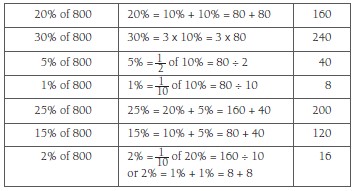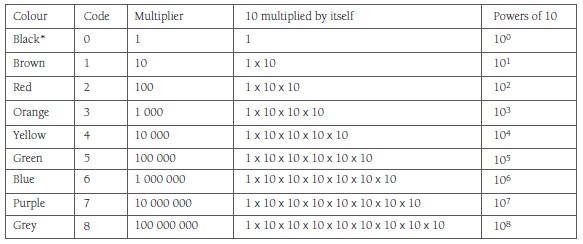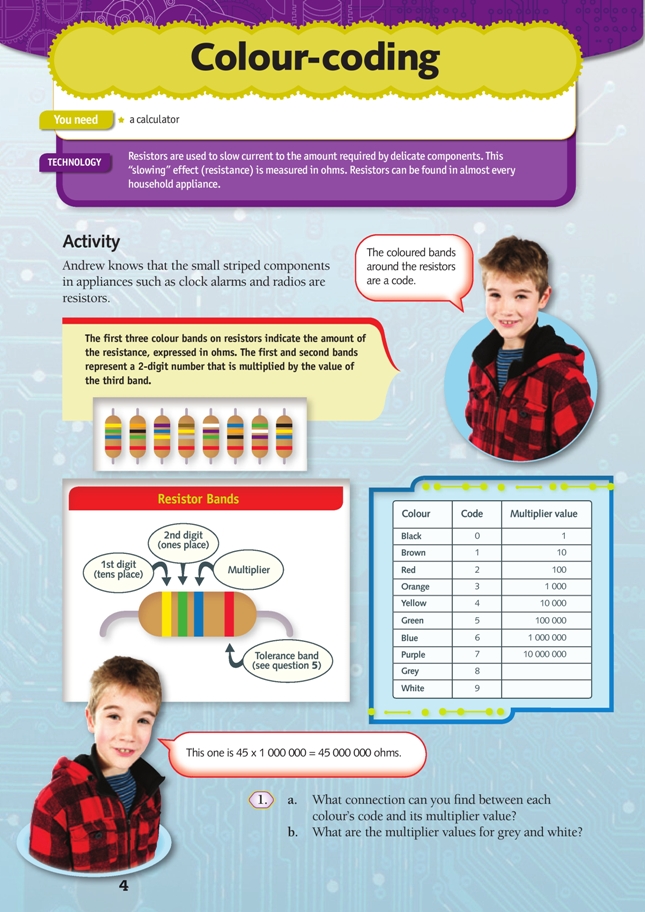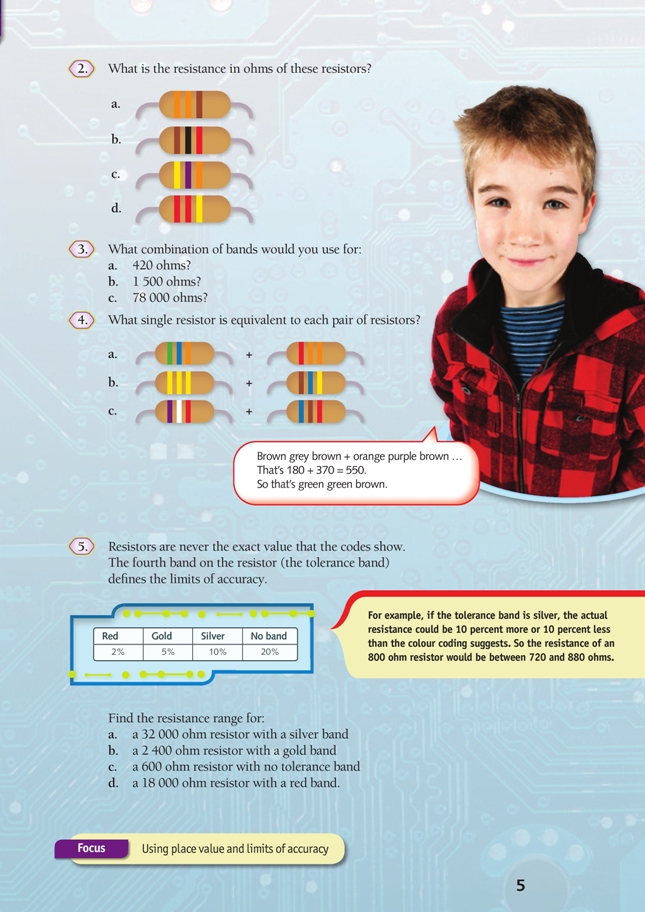This is a level 4 activity from the Figure It Out series.
A PDF of the student activity is included.
Click on the image to enlarge it. Click again to close. Download PDF (960 KB)
A numeral is a symbol, or collection of symbols, that represents a number. The Hindu-Arabic numeral system we use was developed over thousands of years and has its roots in Babylonia. A key stage in its development was the introduction of zero by Indian mathematicians. This system allows us to represent very large numbers using a limited range of symbols. In this activity, students are introduced to an adaptation of this system. Coloured bands represent both the numbers 0–9 and powers of 10. Understanding that there are different systems of numeration can help students to develop their understanding of the Hindu-Arabic system and of place value.
FIO, Technology Transformations, Levels 3+-4+, Colour-coding, pages 4 - 5
Students should enjoy using their knowledge of place value to decode the value of electrical resistors. Understanding the coding used in number systems develops the key competency using language, symbols, and texts.
Most students will see the link between the code and the number of zeros in the multiplier. Extend their thinking by showing them that the code also shows how many times 10 has been multiplied by itself. This lays the foundation for the concept of powers, which are introduced at level 5.
Students could use coloured markers to draw their answers to some questions.
Question 5 can be used to discuss variation and accuracy. Variation exists in all objects, whether natural or man-made. It may seem strange to the students that resistors do not provide an exact amount of resistance. Discuss with them that all measurements are approximations, only as accurate as is needed or practical. For example, measurements of length seldom need to be more accurate than the nearest millimetre. If we want to measure the length of the school field, we would probably only measure it to the nearest metre.
Resistors have varying degrees of accuracy, and the level of tolerance required reflects the sensitivity of the component it is being used with. The fourth band (the tolerance band) on a resistor states what the tolerance is. Although all measurements are approximations, sometimes it is important to know the limits of accuracy of a measurement: what is the range that the actual answer lies within? In many cases, these limits are assumed. For example, if I say that my height is 168 cm, my actual height is likely to be between 167.5 and 168.5 cm.
Percentages are useful for developing proportional reasoning. Using 10% as a base, students can learn to quickly estimate or calculate related percentages. For example, 10% of 800 is 80 (10% = 10/100 = 1/10). This can be used to find a range of related percentages as shown in the table:

Encourage the students to use these techniques to find the limits of accuracy for the resistors in question 5.
Extension
Explore powers of 10 with your students.

* See www.homeschoolmath.net/teaching/zero-exponent-proof.php for a useful way to explain why any number to the power of zero is equal to one.
Technology-related student activities
- Use an LDR (light-dependent resistor) and a buzzer in a simple circuit to make a working model of an alarm that will activate when a light is turned on.
- Design a colour code for batteries of different voltage.
- Design a battery-voltage code that people with visual impairments could interpret.
- Research the effect that transistors have had on technological development. See www.nobelprize.org/ educational/physics/transistor/history/index.html and www.ehow.com/facts_5183096_use-transistors.html
Exploring the technology-related context
Technology and science are closely related. Teachers often introduce students to the scientific concept of circuits, where power sources, outputs, and conductivity are investigated. Students then suggest electronic solutions to a particular problem or respond to an opportunity using their new knowledge. Once students understand the function of components such as switches, buzzers, resistors, capacitors, and LEDs, they enjoy designing simple lighting systems, alarms, “electronic” birthday cards, and interactive quiz boards.
These components can be so small that it is impossible to write technical specifications on them. In such cases, codes may be used. For instance, resistors use a system of coloured bands to indicate the amount of resistance.
Answers to activity
1. a. The colour code shows: how many zeros are in the multiplier; how many times ten has been multiplied by itself to get the multiplier; the power of ten of the multiplier.
b. Grey is 100 000 000; white is 1 000 000 000.
2. a. 33 × 10 = 330
b. 10 × 100 = 1 000
c. 47 × 1 000 = 47 000
d. 22 × 10 000 = 220 000
3. a. yellow, red, brown
b. brown, green, red
c. purple, grey, orange
4. a. 56 000 + 23 000 = 79 000, so purple, white, orange
b. 440 000 + 160 000 = 600 000, so blue, black, yellow
c. 7 900 + 6 100 = 14 000, so brown, yellow, orange
5. a. 10% of 32 000 = 3 200 32 000 – 3 200 = 28 800 32 000 + 3 200 = 35 200; so the resistance is between 28 800 and 35 200.
b. 5% of 2 400 = 120 2 400 – 120 = 2 280 2 400 + 120 = 2 520; so the resistance is between 2 280 and 2 520.
c. 20% of 600 = 120 600 – 120 = 480 600 + 120 = 720; so the resistance is between 480 and 720.
d. 2% of 18 000 = 360 18 000 – 360 = 17 640 18 000 + 360 = 18 360; so the resistance is between 17 640 and 18 360.

